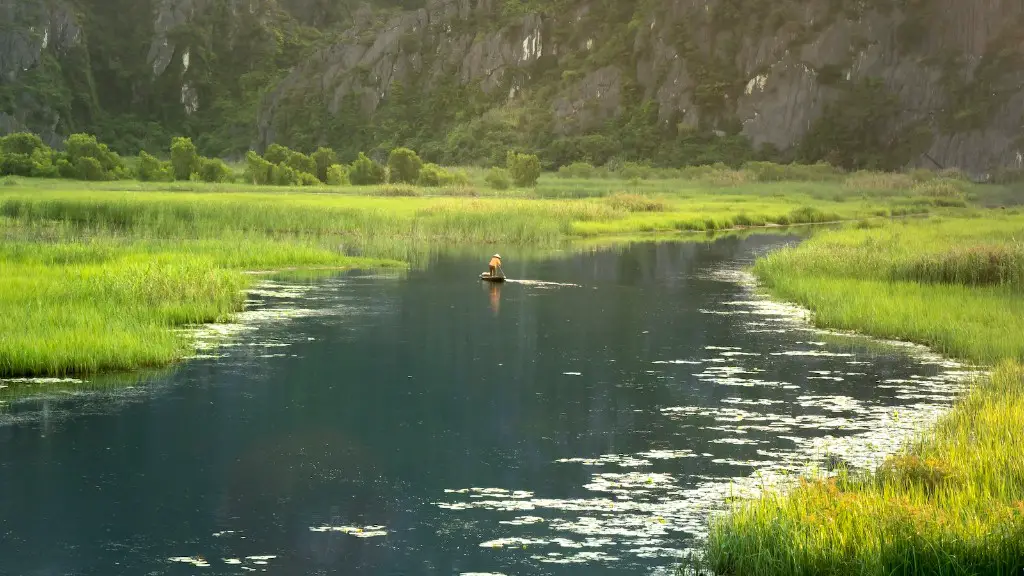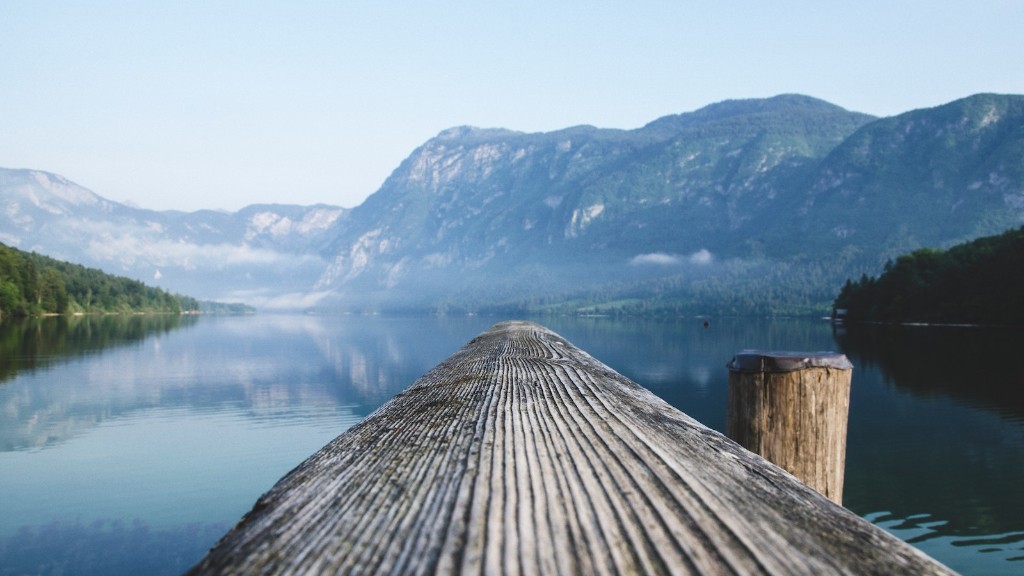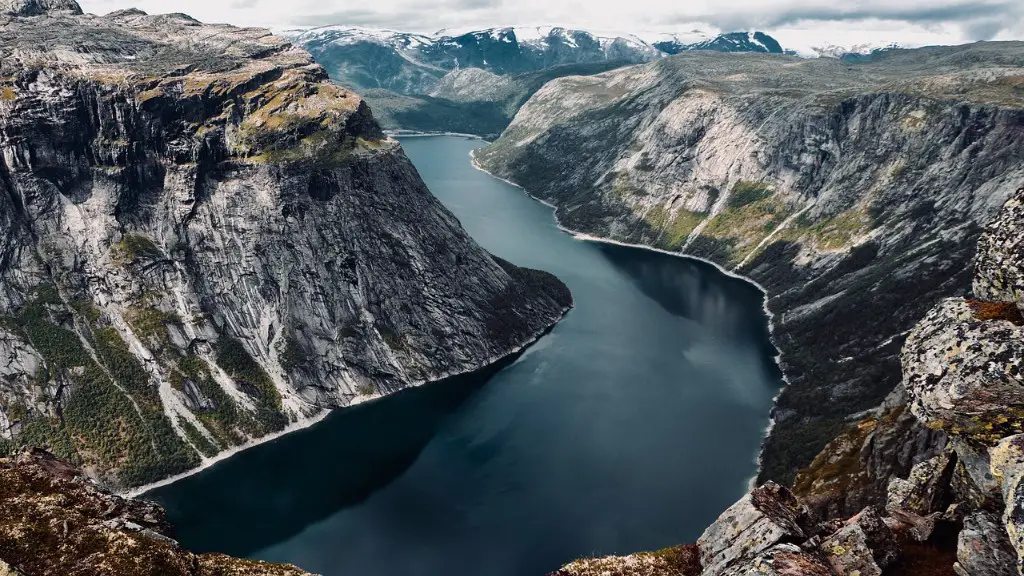The Nile is one of the world’s longest rivers, stretching over 6,853 km (4,258 miles). The river and its tributaries run through eleven countries in northeastern Africa, and empties into the Mediterranean Sea. The Nile’s length, combined with its year-round flow, and the presence of islands and canals throughout its course make it an important waterway for navigation and for freshwater resources for millions of people.
The Nile has been a critical part of life in North Africa for centuries. Its annual flooding, combined with the fertile soil and irrigation systems, has made the Nile a fertile area for farming and an anchor of life for the region. Its length, combined with its navigability, has also made it a crucial trade and communications network as well.
The source of the Nile is located in Uganda, near the equator, and it flows northward through most of Africa, eventually emptying into the Mediterranean Sea. The Nile has many tributaries and lakes, but the longest stretch of its main course is approximately 4,258 miles (6,853 km). The source of the Nile is a major point of contention, with different countries citing sources located within their borders as the origin of the river.
Over the years, damming and irrigation projects along the Nile—such as the Aswan High Dam, completed in 1971 in Egypt— has altered the river’s flow and created new challenges for water resources management. Organizations such as the World Wildlife Fund have raised alarm at the potential effects of further development on the river’s ecosystems, and are actively working to protect some of the most threatened species in the Nile Basin.
Experts from various fields weigh in on the Nile’s importance. Aaron Wolf, the director of the Program in Water Conflict Management and Transformation at Oregon State University, says that the Nile has been “a very unusual river in terms of its geopolitical significance” and that it has historically been “a political resource as much as an economic resource.” Experts point to increasing cooperation and dialogue between the riparian nations of the Nile—including Ethiopia, Sudan, Egypt, and several Central African nations—as an example of how improved understanding of each other’s water needs can lead to improved cooperation.
The Nile plays an essential role in the region’s ecosystems, with many species relying on the river for their habitats. The Nile’s length and its wide range of fish species, reptiles, amphibians and birds make it one of the most important habitats for migratory species in Africa. The marshy Sudd wetlands in South Sudan, formed by the White Nile’s slow-flowing waters, provide another important habitat for species such as the endangered African wild hunting dog.
Environmental Impact of the Nile
The Nile plays an essential role in the environment, resulting in a variety of environmental impacts. Many of the species living in the Nile and in its tributaries, such as the endangered Nile crocodile, have seen their numbers decrease drastically due to pollution and human activities. Other species, such as the Nile perch and a variety of catfish, have become invasive species in areas that have been changed by human activity. Changes in the flow of the river have also resulted in changes in the distribution of species, resulting in much of the river becoming hypoxic, or totally devoid of aquatic life.
Recently, the construction of dams and reservoirs along the Nile has threatened the environment by causing changes to the river’s flow, leading to negative impacts on local aquatic ecosystems and species. The Aswan High Dam, for example, has caused the dramatic water level fluctuations in the Lower Nile, resulting in the displacement of a large number of species and the disruption of their breeding cycles. Other dams, such as the Grand Ethiopian Renaissance Dam, have the potential to cause similar environmental disasters.
Economic Impact of the Nile
The Nile plays a vital role in the economic growth of the region, providing vast opportunities for business, trade, and employment. The river has been used for generations as a means of transportation, as a source of power, and as a source of irrigation water for agriculture. It has also been used to supply water to industries, cities, and towns, providing jobs and economic growth in the process.
The hydroelectric potential of the Nile River and its tributaries has been harnessed to provide electricity, which has helped to drive development and improve quality of life across the region. Dams such as the Aswan High Dam and the Grand Ethiopian Renaissance Dam, for example, have provided much-needed power to the region, including Ethiopia, Egypt, South Sudan, and other countries in East Africa. This has helped to create new opportunities for businesses, provide access to clean energy, and improved access to health care, education and other services.
Political Impact of the Nile
The Nile has been a source of tension between the riparian countries of the Nile Basin for centuries, due to the competition for access to its waters and the need to manage shared resources. The question of who has the right to use the Nile’s waters has caused political conflict between countries such as Egypt, Ethiopia and South Sudan. In recent years, however, closer cooperation and dialogue between the riparian nations of the Nile has led to more peaceful resolution to these conflicts.
The Nile serves as an important source of water for countries such as Egypt and Sudan and plays a vital role in their economies. More recently, the newly independent country of South Sudan has shown an increased interest in making use of the river as well. Increasing cooperation between Ethiopia, Egypt and Sudan is necessary to ensure the equitable use of the Nile’s water resources between the countries.
The Nile Basin Initiative, an intergovernmental body formed in 1999, works to promote cooperation in the management of shared water resources in the Nile basin. This organization is leading the way in finding collaborative solutions to the challenges posed by the Nile, and is a model for how nations can work together to achieve mutually beneficial outcomes.
Conclusion of Water Usage
The Nile is a crucial source of water, food and transportation for millions of people in North Africa and is also a vital economic and political resource. The river is under increasing pressure as a result of population growth, pollution and climate change, but with increased cooperation and understanding between riparian countries, it could continue to provide livelihoods, food, and energy to generations to come.
Influence of Climate Change on the Nile
Climate change is having a significant effect on the environment of the Nile, leading to water shortages and an increased risk of floods. Increasing temperatures are leading to changes in precipitation patterns, resulting in prolonged droughts and floods, which are putting increased pressure on natural resources as well as the people who depend on them. In addition, climate change is making it more difficult for water resources managers to predict river levels and plan for future demand.
Higher temperatures are also making it more difficult to irrigate fields and adequately supply water to cities and towns. The Nile is a key source of water in the region, and any further disruption of its flow due to climate change could lead to an even greater strain on the already fragile water resources in the area.
Climate change is also leading to an increased risk of disease, as increased temperatures can facilitate the spread of waterborne and vector-borne diseases, such as malaria and cholera. These diseases can have a devastating impact on the health of local communities, and are a major concern for those living along the river.
Ecosystem Services of the Nile
The Nile plays an important role in the environment, providing essential ecosystem services such as water purification, flood control, and nutrient cycling. These services are essential to the health of the environment and to the people who rely on the river and its tributaries for their livelihoods.
The Nile provides habitat for a wide variety of species, including fish, reptiles, amphibians, birds, and mammals. It is an important refuge for migratory species, and supports a wide variety of aquatic flora and fauna. The river also helps to cycle nutrients, providing vital fertilizers to the region’s soils and contributing to the health of the entire ecosystem.
The Nile also provides essential flood protection, helping to prevent flooding and allowing people to live and work near the river’s banks. This can help to prevent costly damages from flooding that would otherwise affect homes, businesses, and agricultural land.
Efforts to Preserve the Nile
In recent years, a number of conservation efforts have been undertaken to protect the environment of the Nile, from the installation of fences to protect wildlife to the implementation of restrictions on water usage. Governments and non-governmental organizations have also taken steps to educate the public about the importance of the river and its environment, and to promote the sustainable use of its resources.
Organizations such as the World Wildlife Fund are actively working to protect the threatened species of the Nile and to reduce the threats posed by human activities. These organizations are also advocating for the implementation of policies and practices that will ensure that the Nile’s delicate ecosystems remain healthy and are able to support the human inhabitants of the region.
The Nile is an essential source of life for millions in North Africa and is facing a variety of challenges. With increased cooperation between riparian nations, improved understanding of the importance of the river, and a commitment to conservation, the Nile can continue to bring life, wealth, and opportunities to the region for generations to come.





